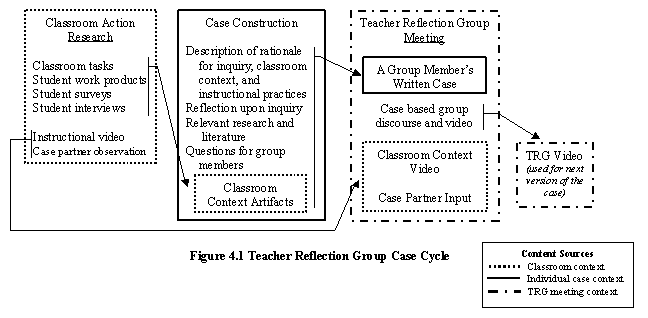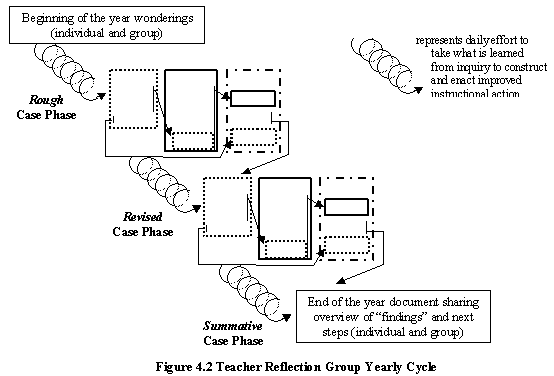The
professionals with whom I learn: The community context of TRG
Timothy Boerst
The goal of TRG as stated in its initial flyer was to "expand insights, knowledge, questions, and strategies for improving teacher understanding and classroom action."
Teacher Reflection Group meets for two hours every other week, except during report card months, in a room at the district's administrative office building. Depending on the year there are anywhere from six to twelve teachers who participate in TRG, with returning group members, so called community "old-timers" (Stein et al., 1998), comprising the majority of group members. The participants represent all four of the district's elementary schools and grade levels 3-5. The teachers vary in age, background, marital status, gender, years of teaching experience, and many other factors. Most hold masters degrees, are active members of their school staffs, and have easily earned all the professional development hours the district allows.
Jump to:
TRG, like other contemporary approaches, can be described in terms of its rationale, goals, content, and processes (Richardson & Anders, 1994). Drawing upon our experience in NBPTS certification, the primary rationale for creating and participating in TRG was that teacher reflection utilizing artifacts of practice, social interaction, and consultation of a variety of sources could enhance teacher learning and improve the experiences of our students. Literature reviewed in previous chapters gives strong support to this rationale. The goal of TRG as stated in its initial flyer was to "expand insights, knowledge, questions, and strategies for improving teacher understanding and classroom action." Long range and immediate goals for teacher learning approaches have a way of changing over time, particularly those that attempt to foster community, but for the most part this goal remains at the core of what TRG attempts to accomplish through its work.
The content and processes of Teacher Reflection Group are the primary research interests of this dissertation. At this point the content and processes meant to facilitate movement toward TRG's goal(s) will be described in rather basic terms to give the reader an overall notion of the work of TRG. The content of TRG is basically channeled through two routes comprised of individual member "cases" and group member interaction. Individual participants create cases, on a rotational basis, to share their action research with the group. They construct cases around topics that are purposefully on the edges of their understanding and problematic for them and their students. Topics for cases are diverse, but often fall within well-defined subject matter, instructional, or professional areas. Cases are comprised of written rationale, descriptions of practice, artifacts from practice (student work samples, instructional video, classroom tasks,…), focus questions, and relevant research or professional readings. Each case is shared multiple times during the school year. A "rough case" is prepared during the first semester, followed by a "revised case" in the second semester, and "ending" with a brief "summative case" document. Each version of the case can be seen as a tentative summary of classroom research that attempts to progressively build upon personal inquiry, insights of the group and other sources. A second route through which content is made available in TRG is through group members who bring case related reactions, experiences, research, or resources with them to TRG meetings. In a way the content of case is constructed anew by the group under the leadership of the case's individual creator. This content is quite diverse including curriculum materials, state benchmarks, school policies, life experiences, teaching beliefs, research pointers, and pedagogical alternatives. At times, and increasingly over time, the issues and ideas of past TRG meetings are available and drawn upon as content that is applicable to the discussion of each case. In a sense, the content for TRG is an amalgamation of current individual cases and group interaction with the various case related sources, including past TRG cases and meetings. The rich mix of content in TRG is another way in which this approach can be seen as an appropriate context for studying the practices of teacher learning in Deliberative Professional Development Communities.

The basic
contents and processes of TRG create an approach to teacher learning which
spans an entire school year, progressively building upon the action research
of its members and its own accumulated body of interactions. Figure 4.2
represents the current work of TRG across a school year to integrate ideas
and skills from many contents, contexts, participants, and sources. At
present every group member's case is taken through all four phases, whereas
in years one and two of TRG cases were only taken through the rough case
phase.
